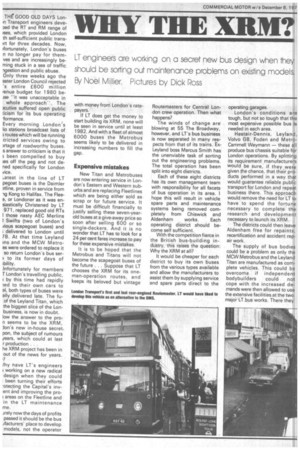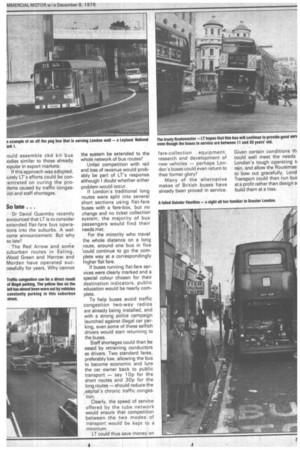WHY THE XRM?
Page 66

Page 67

If you've noticed an error in this article please click here to report it so we can fix it.
LT engineers are working on a secret new bus design when they should be sorting out maintenance problems on existing models. By Noel Miller. Pictures by Dick Ross
THff GOOD OLD DAYS Lon;n Transport engineers deveDed the RI and RM range of ises, which provided London th self-sufficient public transirt for three decades. Now, 'fortunately, London's buses n no longer pay for themves and are increasingly beming stuck in a sea of traffic igestion and public abuse. Only three weeks ago the aater London Council rejected 's entire £600 million fenue budget for 1980 beJse it was unacceptable in
whole approach". The .icutive suffered open public :icism for its bus operating -formance.
Every morning London s lio stations broadcast lists of routes which will be running tricted services owing to )rtage of roadworthy buses. s answer to criticism is that it ; been compelled to buy ;es off the peg and not dened specifically for London vice.
_atest in the line of LT pegoat buses is the Daimler ?Aline, proven in service from ig Kong to Halifax. The Fleea, or Londoner as it was ensiastically Christened by LT 971, replaced good old RTs I those nasty AEC Merlins I Swifts (two of London's vious scapegoat buses) and ; delivered to London until 78. At that time Leyland ins and the MOW Metroas were ordered to replace it so return London's bus ser: to its former days of ibility.
Jnfortunately for members T London's travelling public, by this time had rapidly ied to their own cars to al, both types of buses were ally delivered late. The fuof the Leyland Titan, which the biggest slice of the Lonbusiness, is now in doubt. low the answer to the pron seems to be the XRM, lon's new in-house secret. pon, the subject of rumours /ears, which could at last r production . .
he XRM project has been in out of the news for years. '?
/hy nave LT's engineers working on a new radical design when they could been turning their efforts 'otecting the Capital's invent and improving the pro' areas on the Fleetline and in the LT maintenance me.
rely now the days of profits passed it should be the bus Jfacturers' place to develop models, not the operator with money from London's ratepayers.
If LT does get the money to start building its XRM, none will be seen in service until at least 1982. And with a fleet of almost 6000 buses the Metrobus seems likely to be delivered in increasing numbers to fill the gap.
Expensive mistakes
New Titan and Metrobuses are now entering service in London's Eastern and Western suburbs and are replacing Fleetlines which are being either sold as scrap or for future service. It must be difficult financially to justify selling these seven-yearold buses at a give-away price so soon after selling 600 or so single-deckers. And it is no wonder that LT has to look for a 24 per cent fares increase to pay for these expensive mistakes.
It is to be hoped that the Metrobus and Titans will not become the scapegoat buses of the future . . Suppose that LT chooses the XRM for its oneman-operation routes, and keeps its beloved but vintage Routemasters for Central London crew operation. Then what happens?
The winds of change are blowing at 55 The Broadway, however, and LT's bus business
is now separated in many res-, pects from that of its trains. Ex
Leyland boss Marcus Smith has the unenviable task of sorting out the engineering problems. The total operation has been split into eight districts.
Each of these eight districts has its own management team with responsibility for all facets of bus operation in its area. I hope this will result in vehicle spare parts and maintenance systems being removed completely from Chiswick and Aldenham works. Each operating district should become self sufficient.
With the competition fierce in the British bus-building industry, this raises the question: Why the XRM at all?
It would be cheaper for each district to buy its own buses from the various types available and allow the manufacturers to assist them by supplying service and spare parts direct to the operating garages.
London's conditions are tough, but not so tough that the most expensive possible bus is needed in each area.
Hestair-Dennis. Leylan Volvo GB, Foden and Metr Cammell Weymann — these 411 produce bus chassis suitable f London operations. By splitti its requirement .manufacturers would be sure, if they were given the chance, that their products performed in a way that would guarantee reliable public transport for London and repeat business there. This approach would remove the need for LT to have to spend the fortune necessary to complete the research and development necessary to launch its XRM.
The districts could then leave Aldenham free for repaints, recertification and accident repair work.
The supply of bus bodies could be a problem as only the MCVV Metrobus and the Leyland Titan are manufactured as complete vehicles. This could be overcome if independent bodybuilders could not cope with the increased demands were then allowed to use the extensive facilities at the two major LT bus works. There they :ould assemble ckd kit bus )odies similar to those already xDpular in export markets.
If this approach was adopted, ;urely LT's efforts could be conentrated on curing the proDlems caused by traffic congession and staff shortages.
So late . . .
Dr David Quarrnby recently announced that LT is to consider extended fiat-fare bus operations into the suburbs. A welcome announcement. But why so late?
The Red Arrow and sore suburban routes in Ealing, Wood Green and Harrow and Morden have operated successfully for years. Why cannot the system be extended to the whole network of bus routes?
Unfair competition with rail and loss of revenue would prob ably be part of LT's response although I doubt whether either problem would occur. If London's traditional long routes were split into several short sections using flat-fare buses• with a fare-box, but no change and no ticket collection system, the majority of bus passengers would find their needs met.
For the minority who travel the whole distance on a long route, around one bus in five 'could continue to go the complete way at a correspondingly higher flat fare.
If buses running flat-fare services were clearly marked and a special colour chosen for their destination indicators, public education would be nearly complete.
To help buses avoid traffic congestion two-way radios are already being installed, and with a strong police campaign launched against illegal car parking, even some of these selfish drivers would start returning to the buses.
Staff shortages could then be eased by retraining conductors as drivers. Two standard fares, preferably low, allowing the bus to become economic and lure the car owner back to public transport — say 10p for the short routes and 30p for the long routes — should reduce the capital's chronic traffic congestion.
Clearly, the speed of service offered by the tube network would ensure that competition between the two modes of transport would be kept to a minimum.
LT could thus save money on fare-collection equipment, research and development of new vehicles — perhaps London's buses could even return to their former glory?
Many of the alternative makes of British buses have already been proved in service.
Given certain conditions th could well meet the needs London's tough operating ti rain, and allow the Routemas. to bow out gracefully. Lond Transport could then run bus at a profit rather than design a build them at a loss.
























































































































































